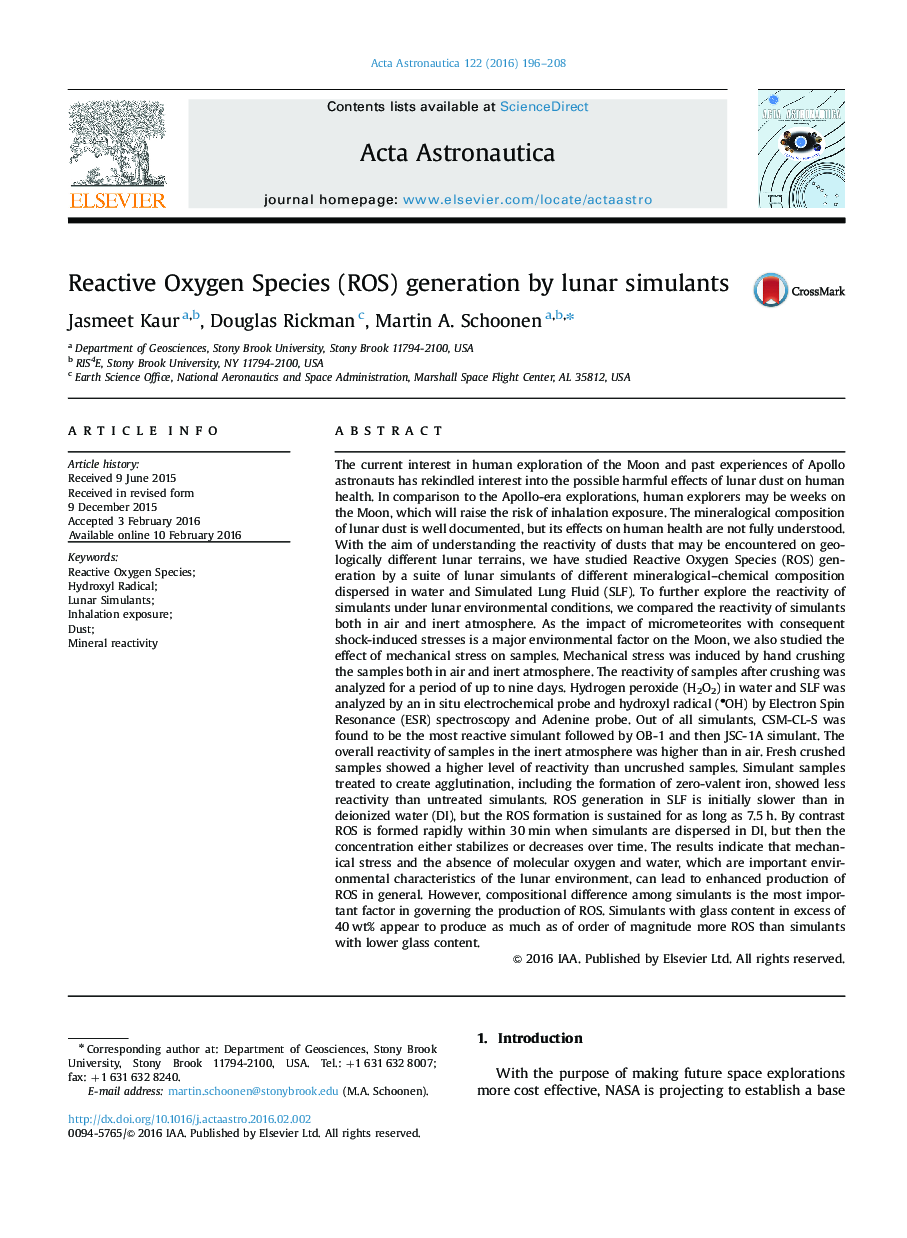| کد مقاله | کد نشریه | سال انتشار | مقاله انگلیسی | نسخه تمام متن |
|---|---|---|---|---|
| 8056278 | 1519932 | 2016 | 13 صفحه PDF | دانلود رایگان |
عنوان انگلیسی مقاله ISI
Reactive Oxygen Species (ROS) generation by lunar simulants
دانلود مقاله + سفارش ترجمه
دانلود مقاله ISI انگلیسی
رایگان برای ایرانیان
کلمات کلیدی
موضوعات مرتبط
مهندسی و علوم پایه
سایر رشته های مهندسی
مهندسی هوافضا
پیش نمایش صفحه اول مقاله

چکیده انگلیسی
The current interest in human exploration of the Moon and past experiences of Apollo astronauts has rekindled interest into the possible harmful effects of lunar dust on human health. In comparison to the Apollo-era explorations, human explorers may be weeks on the Moon, which will raise the risk of inhalation exposure. The mineralogical composition of lunar dust is well documented, but its effects on human health are not fully understood. With the aim of understanding the reactivity of dusts that may be encountered on geologically different lunar terrains, we have studied Reactive Oxygen Species (ROS) generation by a suite of lunar simulants of different mineralogical-chemical composition dispersed in water and Simulated Lung Fluid (SLF). To further explore the reactivity of simulants under lunar environmental conditions, we compared the reactivity of simulants both in air and inert atmosphere. As the impact of micrometeorites with consequent shock-induced stresses is a major environmental factor on the Moon, we also studied the effect of mechanical stress on samples. Mechanical stress was induced by hand crushing the samples both in air and inert atmosphere. The reactivity of samples after crushing was analyzed for a period of up to nine days. Hydrogen peroxide (H2O2) in water and SLF was analyzed by an in situ electrochemical probe and hydroxyl radical (
- OH) by Electron Spin Resonance (ESR) spectroscopy and Adenine probe. Out of all simulants, CSM-CL-S was found to be the most reactive simulant followed by OB-1 and then JSC-1A simulant. The overall reactivity of samples in the inert atmosphere was higher than in air. Fresh crushed samples showed a higher level of reactivity than uncrushed samples. Simulant samples treated to create agglutination, including the formation of zero-valent iron, showed less reactivity than untreated simulants. ROS generation in SLF is initially slower than in deionized water (DI), but the ROS formation is sustained for as long as 7.5Â h. By contrast ROS is formed rapidly within 30Â min when simulants are dispersed in DI, but then the concentration either stabilizes or decreases over time. The results indicate that mechanical stress and the absence of molecular oxygen and water, which are important environmental characteristics of the lunar environment, can lead to enhanced production of ROS in general. However, compositional difference among simulants is the most important factor in governing the production of ROS. Simulants with glass content in excess of 40Â wt% appear to produce as much as of order of magnitude more ROS than simulants with lower glass content.
- OH) by Electron Spin Resonance (ESR) spectroscopy and Adenine probe. Out of all simulants, CSM-CL-S was found to be the most reactive simulant followed by OB-1 and then JSC-1A simulant. The overall reactivity of samples in the inert atmosphere was higher than in air. Fresh crushed samples showed a higher level of reactivity than uncrushed samples. Simulant samples treated to create agglutination, including the formation of zero-valent iron, showed less reactivity than untreated simulants. ROS generation in SLF is initially slower than in deionized water (DI), but the ROS formation is sustained for as long as 7.5Â h. By contrast ROS is formed rapidly within 30Â min when simulants are dispersed in DI, but then the concentration either stabilizes or decreases over time. The results indicate that mechanical stress and the absence of molecular oxygen and water, which are important environmental characteristics of the lunar environment, can lead to enhanced production of ROS in general. However, compositional difference among simulants is the most important factor in governing the production of ROS. Simulants with glass content in excess of 40Â wt% appear to produce as much as of order of magnitude more ROS than simulants with lower glass content.
ناشر
Database: Elsevier - ScienceDirect (ساینس دایرکت)
Journal: Acta Astronautica - Volume 122, MayâJune 2016, Pages 196-208
Journal: Acta Astronautica - Volume 122, MayâJune 2016, Pages 196-208
نویسندگان
Jasmeet Kaur, Douglas Rickman, Martin A. Schoonen,